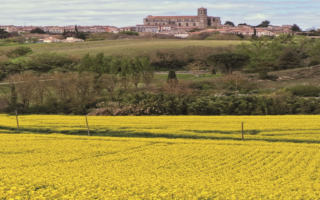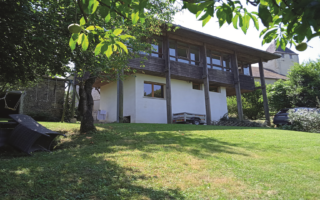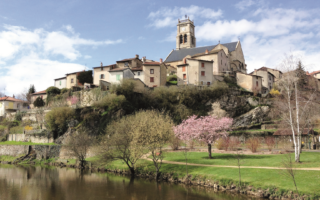‘The mad English keeping some very strange animals!’
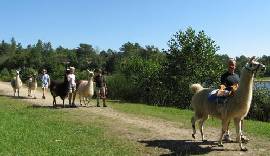

‘It’s time we took control of our lives… rather than letting time take control,’ we said to ourselves, sitting on a log in a campsite on an island in the middle of the river Charente near Cognac.
And so the decision was taken to follow that well-trodden route from Britain to France in search of that Shangri-La change in lifestyle. Good food and wine, the pace of life and the weather had all woven their seductive spell, and this was coupled with the prospect of a possible sixth house move in 12 years, due to work. The thought of endless years in another traffic congested corner of Britain and the job security of a 50+ year old senior manager all combined to start the house hunt for that French dream.
Initially wrecks and near wrecks were looked at but then realism set in and the thought of living in a building site for two to three years plus the unknown costs of renovation resulted in us settling on a 15-year old Charentais style house that came with a tower, pool and a fantastic view. Although it needed work done to it, it was habitable wand could be ours without a mortgage with equity left over. A ‘no-brainer’!
TEN MONTHS WITHOUT AN INCOME
Being early retirees we had a few years before our pensions started paying out so we needed to generate some income in the meantime. We had a number of ideas, believing that we could switch from one to another following demand. Our first was renewable energy – with an abundance of sun it seemed logical to set up a business to promote in France what we considered to be the best solar water heater system manufacturer (Thermomax) in the UK, to promote them in France.
We thought it would easy – just like in the UK. We were very mistaken. In the end we thad to close the business down because we risked losing all our equity. We failed for three reasons:
– the cost of running a SARL (a limited liability company) was hugely expensive. Unlike in Britain you can easily buy a £100 company off the shelf through ‘Dalton’s Weekly’ and the taxes and social charges reflect the company’s turnover, both in value and timing. In France, however, the cost is between 1,500€ and 2,000€ and once registered the social security charges are pre-set irrespective of the level of activity. Our first invoices arrived within a fortnight and then continued to arrive with alarming regularity. The fact that these charges would be corrected in later years did not help us in our first year where we needed a working capital of about 10,000€ just to pay these charges.
– hand ups, we had not done enough market investigation – we tried three to four years too early. Back in the early 2000s, the market was not ready and the many government grants and cultural approach to the issue now in place were not there. At the same time, there had been a solar heating development in our area in the early nineties which had failed so now all solar heating systems were tarred with this same brush.
– French protectionism meant what grants did exist were only available for French manufactured ‘NF’ rated products! Thermomax did investigate obtaining them but said the testing procedure would cost over £100,000 and take at least two years.
So after 10 months with virtually no income and considerable promotional spend as well as social charges we put the company to sleep.
Having entered the system, we now reaped a few benefits from it. We did get some of that money back and support was available as well. We did also get some part-time work. All the while, though, the search for a our own enterprise did not stop and one Sunday morning whilst watching ‘Countryfile’ a report on llama trekking in Northern England caught the imagination and started a long process of investigation and careful assessment.
SELLING UP AND MOVING ON
We needed to learn as much as we could about raising and trekking (or ‘packing’ as it is called in the USA) and then try to determine if it had commercial potential. As we took our voyage into llama world we became more and more enchanted by both the animals and their owners. All 12 breeders we met in both Britain and France were true enthusiasts, giving us all the information we needed to know about these animals. The risk was that we were so enamoured by these creatures that we could lose sight of the commercial aspects!
Although some of the breeders were set-up commercially, they all had other activities to support the llama activity. Quite a few kept llamas for a hobby with the challenge of competitions and sold surplus crias (baby llamas) to prevent in-breeding and to make some money to pay for their hobby.
We had to stay focussed on earning a small living.
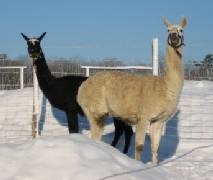 Despite our and our mayor’s best efforts we could not find any suitable land for our animals so we had to sell and find a new location – a major risk. We were using all of our equity to finance both a new home and the capital for the business with its promotional costs.
Despite our and our mayor’s best efforts we could not find any suitable land for our animals so we had to sell and find a new location – a major risk. We were using all of our equity to finance both a new home and the capital for the business with its promotional costs.
After a wide ranging search we found a parcel of land with out-buildings unsuitable for renovation, but good for supporting the animals so despite our original misgivings, we ended up in a mobile home on a building site for six months whilst our new house was built. At the same time we prepared the site for the animals as well as buying them, training them and marketing our proposed activity.
Apart from price, our final selection of the land near Brossac south Charente was influenced by the level of tourist activity in the area, including the nearby Etang Vallier with its Village de vacance and the Grande Randonnée pathway GR36 along two sides of our property.
ENTERING LLAMA WORLD
Llamas, originally from South America, are versatile animals – apart from trekking they are used for wool production (although their cousin the Alpacas produce finer wool), guarding flocks of sheep, undergrowth clearance particularly on steep slopes, and as pets. They do not like excessive heat (over 30 degrees celcius) so need shade but the cold is no worry, the animals happily sleeping outside in -10 degrees!
They each have very distinct and different characters and the selection of our animals was made according our primary activity – trekking. We looked for calm, malleable and sturdy animals. Our research had shown us what comportment and form we should try to find. Males are generally better trekkers than females, so we decided to buy five males as well as three females so we could breed for our own use.
All llamas are very inquisitive and quite intelligent; training is more a matter of patience and repetition than special techniques. They are pack animals but unlike horses are not for riding. When training for trekking, the first skill to be learned is the ability to carry saddles (to can hang rucksacks or panniers, not sit on). The next stage is to familiarise them with the route. Although generally very calm and placid, noisy dogs can be alarming to them.
With the training ongoing, we designed a website, logo, flyers and posters to provide the promotional material. Distribution was not easy. Regional Offices of Tourisme are not as ‘joined-up’ as one may think and inter-departmental rivalry makes promotion in a neighbouring départment not always easy. We also had an unique product so yet again we were faced with the problem of creating a market. We needed free publicity which was achieved through five newspaper articles and a TV report, plus a very helpful departmental Conseiller Général, who opened many doors.
We found before we opened that we had become quite a curiosity to the locals. The word spread quickly about ‘these mad English’ keeping these exotic animals in an area more used to hunting than husbandry! People kept on turning up to see the llamas, wandering onto our property, (until we fitted the gates), as if by right. We politely explained what we were doing and then asked them to leave. This was sometimes thought to be very odd. Odder still was the concept of paying to take animals on a lead along public footpaths!
Although we have a number of options ranging from an hour’s stroll to an all day trek either starting from our base or from other locations, we had assessed that the most common form of trek would comprise a three hour trek in the morning, returning to our base for a leisurely four course buffet meal with local wines on the terrace looking over the llamas in the field from 35€.
LLAMAS AS THERAPY
We had decided, after taking advice from our earlier investigations, to exclude children under nine years old or 1.2m high from the treks because they would not be able to control the animals or have the stamina for the walk and parents would end up carrying the child for 1-2 hours thus reducing their own enjoyment. This decision was proved to be correct when we relented on a couple of occasions.
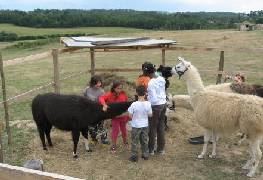 However, recognising there was a demand for the younger children we started a Llama Encounter (even before we had formerly opened), where children can enter the coral with the llamas, feeding them, stroking and getting close and friendly and finally, if they wanted to, taking them for a stroll around the safety of our field. This has proved to be very popular even with the locals, where grandparents searching for something to do with the little ones found our ‘Encounter’ provided a great photo opportunity and all for only 6€ a head!
However, recognising there was a demand for the younger children we started a Llama Encounter (even before we had formerly opened), where children can enter the coral with the llamas, feeding them, stroking and getting close and friendly and finally, if they wanted to, taking them for a stroll around the safety of our field. This has proved to be very popular even with the locals, where grandparents searching for something to do with the little ones found our ‘Encounter’ provided a great photo opportunity and all for only 6€ a head!
Two of our ‘Encounters’ led us to a new area: the first was a ‘Moulin Pedalogique’ where disturbed children from all over France were on holiday/treatment. Three of the children who arrived were frightened of animals but after one hour with the llamas, they were putting arms around the animals’ necks and did not want to leave when the time came to depart.
Shortly after a therapist from a residence for people who had suffered from head injuries asked if they could bring some handicapped people to meet the llamas. We readily agreed as we had already found this use of llamas in our research and we had built our reception to accommodate handicapped people with toilettes fully adapted. The response from the people, who previously were most unresponsive to stimuli, shook the carers that had brought their patients. Greatly encouraged this has led to regular sessions.
The Charente is in a process of developing its Village Verte and is raising its profile to accommodate handicapped tourists and their families. Our activity complements and supports this objective, benefiting those that meet our incredible animals and experience their therapeutic influence. The use of Animal Aided Activity or Therapy has been developing over the last 20 years in the western world. Llamas work well as they are more placid than most other animals and are large enough to be touched from a wheelchair or bed, can be caressed or brushed, can help with people walking and if a patient stumbles or leans on the animal it is sturdy enough to take their weight. There is no doubt that it not only helps the patients but also gratifies the animal handler every time, giving us that warm feeling.
In 2008 we will develop our activities further sharing our wonderful animals with others mixing tourism with therapy – a great way to enjoy the country and earn a small living.
Les Lamas de Brossac, Chez Beleteau, 16480 Brossac. Tel: 05 45 98 90 58
Watch a TV report
Planning to run a business in France? See FrenchEntrée’s Employment Zone
Share to: Facebook Twitter LinkedIn Email
More in activity, businesses, charente, children, courses, renovation, wine
By FrenchEntrée
Leave a reply
Your email address will not be published. Required fields are marked *

